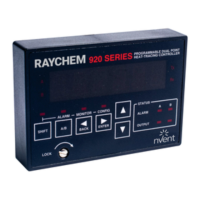37 / 82
EN- Raychem920series-IM-H5687405/15
INDUSTRIAL HEAT TRACING SOLUTIONS
before the corresponding alarm will be indicated.
• Iftheuserresetsanalarmwhilethealarmconditionisstillexists,thealarmwillnotbe
indicated again until the entire alarm filter time has expired.
3.8.14 HIGH RESISTANCE ALARM
Purpose: Alarms heater resistance levels that have increased from the NOMINAL RESISTANCE
setting by more than the selected amount. The HIGH RESISTANCE ALARM may be used to indicate
an open or a high resistance connection or, when using constant-wattage parallel cables, may
indicate the failure of one or more heating zones. It may also be used to monitor a failed series-
type cable or connection in 3-phase applications while minimizing nuisance alarms created by
voltage fluctuations.
Alarm Mask: ENABLE or DISABLE
Range: 1 to 250% (deviation from NOMINAL RESISTANCE)
Procedure: Adjust the HIGH RESISTANCE ALARM level to the desired value. The HIGH
RESISTANCE ALARM must be enabled to adjust the HIGH RESISTANCE deviation.
IMPORTANT:
• UsingtheLOWCURRENTALARMfeaturetoensurethatunexpecteddecreasesincurrent
consumption by the heating cable are alarmed is a reliable method of monitoring the integrity
of series-type heating cables. When using parallel-type heaters (zoned constant-wattage or
self-regulating) or in 3-phase installations, the LOW CURRENT ALARM setting must be chosen
as close as possible to the lowest expected current to detect failed zones, cable degradation,
or a lost phase. The problem with such a close setting is that it inevitably leads to nui-sance
alarms, particularly when voltage fluctuations are present. By using the HIGH RESISTANCE
ALARM, nuisance alarms due to voltage dips may be minimized.
• UseoftheHIGHRESISTANCEALARMassumesthatthecontrollerpowerisderivedfrom
the same circuit as the tracing power (either by direct connection or through a step-down
transformer). Disable this alarm if the controller is powered from a separate circuit.
• Becarefulwhenusingthisalarmfeaturewithheatingcablesthatexhibitavariableresistance
with temperature. High resistance alarming may not be as effective if the load has a decreasing
resistance with temperature.
• NoHIGHRESISTANCEALARMSwillbegeneratedifthemeasuredvoltageisbelowtheLOW
VOLTAGE ALARM setpoint, regardless of whether the LOW VOLTAGE ALARM is enabled. This
stops an alarm from being generated when the circuit power is turned off. If the LOW VOLTAGE
ALARM is disabled ensure that the LOW VOLTAGE setpoint is set to a relevant level, otherwise
no HIGH RESISTANCE ALARMS will occur.
• HIGHRESISTANCEALARMSwillonlybegeneratediftheoutputswitchison.
3.8.15 HIGH RESISTANCE ALARM FILTER TIME SETTING (V3.11 AND UP)
Purpose: The HIGH RESISTANCE ALARM FILTER will prevent HIGH RESISTANCE ALARMS
from being indicated until a high resistance condition has existed for the duration of the HIGH
RESISTANCE ALARM FILTER time.
Range: 0 to 12 seconds
Procedure: Adjust the HIGH RESISTANCE ALARM FILTER time to the desired value. The HIGH
RESISTANCE ALARM must be enabled to adjust the HIGH RESISTANCE ALARM FILTER time.
IMPORTANT:
• Ifanalarmconditionappearsandthendisappearsbeforethealarmfiltertimehasexpired,the
filter timer is reset and the alarm condition must exist again for the entire alarm filter time

